| کد مقاله | کد نشریه | سال انتشار | مقاله انگلیسی | نسخه تمام متن |
|---|---|---|---|---|
| 5629444 | 1580207 | 2017 | 7 صفحه PDF | دانلود رایگان |

- Endovascular therapy can be limited by inadequate access to the fistula point, non-target embolization, and recanalization risk.
- After surgical treatment, symptoms improved in 5 (83.3%), stayed the same in 1(16.7%). In all cases total elimination of arteriovenous shunting was achieved.
- Complete occlusion of the shunt may not lead to clinical improvement if symptoms had been progressing for an excessively long period of time before curative treatment was initiated.
- The patient remains at risk of rebleeding as long as the shunt is open.
BackgroundThe optimal management of skull base DAVFs remains controversial. Some groups advocate endovascular therapy, which is an efficient therapeutic option, but can be limited by inadequate access to the fistula point, non-target embolization, and recanalization risk. We report our experience in microsurgical obliteration after embolization failure, emphasizing the importance of a prompt effective treatment for the long-term clinical status improvement.Patients and methodsThis is a retrospective review, on 6 patients undergoing surgery for skull base Cognard grade IV DAVF after one or several failed embolization procedures in our institution between January 2006 and July 2016. Patients and treatments characteristics/outcomes are reported.ResultsIn all patients endovascular therapy had failed prior to surgery. The mean modified Rankin scale from diagnosis to preoperative surgical cure increased from 1.8 range to 2.7. After surgical treatment, symptoms improved in 5 (83.3%), stayed the same in 1 (16.7%). In all cases total elimination of arteriovenous shunting was achieved, without hemorrhage and recurrence during the mean follow-up period of 5.4Â years.ConclusionSurgical occlusion of skull base Cognard IV DAVFs yields excellent exclusion rate. However, complete occlusion of the shunt may not lead to clinical improvement if symptoms had been progressing for an excessively long period of time before curative treatment was initiated. Hence the patient remains at risk of rebleeding as long as the shunt is open. We do believe that a single stage endovascular attempt can be decided, but a failed procedure should lead to immediate surgery.
Journal: Interdisciplinary Neurosurgery - Volume 9, September 2017, Pages 48-54